Published
on 9
Jun 2023
|
All rights reserved.
|
|
|
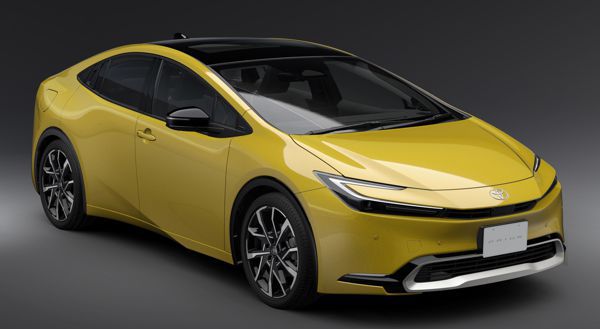 |
|
It
needs to look handsome. It needs to be quick. It needs to be fun to
drive. In other words, it needs to be “un-Prius”.
|
|
Being
the world’s first mass production hybrid vehicle, Toyota Prius has
enjoyed enormous success over the past 25 years. In its hey days, sales
topped over 500,000 units a year, making it one of the fastest selling
cars in the world. However, as oil prices dropped and hybrid technology
became widely available elsewhere, Prius has lost its halo. According
to my own estimation, sales of the outgoing 4th generation Prius
dropped from its predecessor’s 2.2 million units to around 1.5 million
units, even though its life was extended by 1 year. Sales decline in
the US market was especially obvious, from 180,000 units peaked in 2007
to just 37,000 units last year, so few that might risk its
continuation. What’s wrong with the Prius?
Today, you can buy hybrid cars from just about any mass market brands,
let alone EVs. While Prius is dedicated to hybrid power and therefore
achieves the highest fuel efficiency, its advantages over rivals are no
longer that significant. This means selling fuel economy is no longer
enough to lure buyers. You need to be competitive in all other aspects
as well. Unfortunately, the outgoing Prius looked weird, ran slowly and
hated to be hustled on twisty roads. The Prius nameplate has always
been associating with a boring image: you drive it just because you are
interested to save fuel, nothing else interesting. More problematic
still, those used to be enjoying the green halo brought by Prius have
all turned to Tesla or other EVs, leaving only very cost-conscious
buyers to stay. Obviously, to turnaround the declining trend, Toyota
has to make radical changes to the concept of Prius. It needs to look
handsome. It needs to be quick. It needs to be fun to drive. In other
words, it needs to be “un-Prius”. Here comes the Mk5…
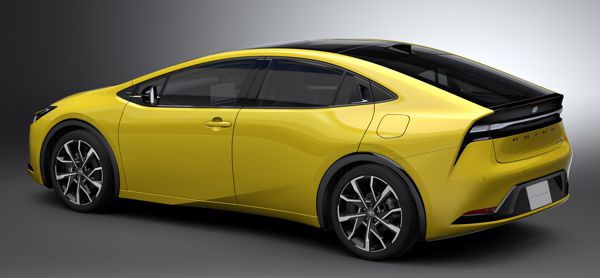 |
|
The
monospace shape with incredibly fast wind and rear screens give a
Sci-Fi look, though does hamper headroom.
|
|
Offering up to 223 horsepower, 0-60 mph accomplished in 6.6 seconds,
riding on double-wishbone rear suspension and 19-inch wheels, does it
sound like a hot hatch? If that's not enough, look at its wedge shape,
the very slim nose, incredibly fast windscreen and fastback, flared
fenders and a low roof line that stands just 1430 mm above ground -
that's lower than a BMW 4-Series Gran Coupe - can you believe this is
the latest Toyota Prius?
The 5th generation Prius is really mold-breaking. Toyota said it is
just as fuel efficient as the Mk4, but at the same time it improves
massively in performance. As before, there are HEV (hybrid) and PHEV
(plug-in hybrid) versions to choose from, but both enjoy power boost.
The base HEV keeps 1.8-liter engine and Toyota's hybrid synergy system
(2 motors and a planetary CVT linking them to the engine). Its combined
output is lifted from 122 to 140 hp, managing to do 0-60 mph in 8.7
seconds. That might not be a huge leap from the old car, but now there
is a hotter 2.0-liter version on offer. Its 2.0-liter Dynamic Force
direct injection engine improves combined output to 194 hp and 0-60 to
merely 7.2 seconds, qualified to be a "warm hatch".
The PHEV, or Prius Prime, is even stronger. Combining the same
2.0-liter engine with a more powerful electric motor results in 223
horsepower and 0-60 in 6.4 seconds. Hopefully it can transform the
image of Prius from an appliance to something attracting younger
drivers, just as the vibrant body color options available this time
around.
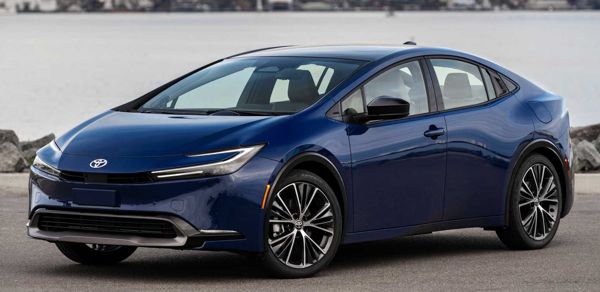 |
|
0-60
mph now takes down to 6.6 seconds, versus the previous 10+.
|
|
The PHEV's lithium battery has its capacity increased from 8.8 to 13.6
kWh. As Toyota said fuel efficiency remains unchanged, driving range
has increased by 50 percent. While the old car managed only 25 miles
(40 km) on a charge, the new one achieves 39-44 miles (depending on
wheel size) according to EPA or 87 km according to Japanese standard,
which is sufficient for the daily commute of most people. Besides, its
roof-mounted photovoltaic cells are said to be able to add 1250 km or
777 miles annually, suppose you always park it outdoors.
The packaging of PHEV is also improved. Toyota moves its battery from
under boot floor to under the rear seat, while fuel tank is on the
contrary. As the fuel tank is easily shaped to fit into the suspension
subframe, the boot floor can be lowered, increasing luggage space.
Moreover, the lower mounted battery contributes to lower center of
gravity, improving handling.
Size-wise, the new Prius is 25 mm longer than before at 4600 mm, 20 mm
wider at 1780 mm and 40 mm lower at 1430 mm. Its wheelbase is stretched
by 50 mm to 2750 mm. The front track is a whopping 60 mm wider thus
should benefit handling. Such a wedge profile is actually less
aerodynamic efficient than the outgoing teardrop shape, lifting Cd from
0.24 to 0.27, but part of that gain is offset by the smaller frontal
area.
As before, the car rides on struts suspension up front and a multi-link
setup at the back that Toyota refers to “double-wishbones”. Wheels have
been enlarged from max. 17-inch previously to 19-inch, allowing it to
stick with 195mm tires across the range to cut drag while enlarging
contact patch area hence traction and grip. The platform is said to be
the second generation TNGA platform. Its body is claimed to be stiffer,
though no figures have been provided. Most models are FWD only, but 4WD
option using a small rear electric motor is available.
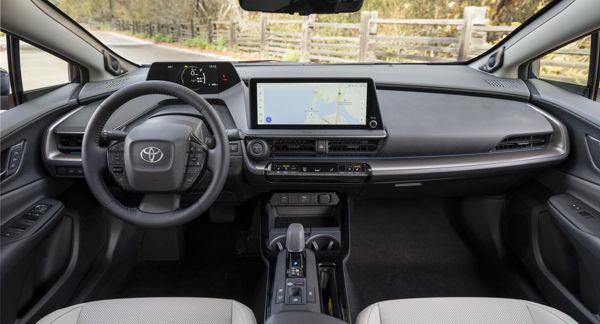 |
|
Instrument
panel finally locates at the rear place!
|
|
The new interior is more driver-friendly, thanks to a less upright
driving position and a digital instrument located at the right place.
The portrait touchscreen on the old car has been changed to landscape
view and positioned higher at the dash top, which is more ergonomical.
Toyota is wise to avoid relying on touch controls, keep using hard
buttons at the center console and steering wheel. The dashboard is
lowered slightly from the cowl to improve the perception of
spaciousness. The lower and faster roofline does hamper headroom
though. Front and rear seat lose 35mm and 25mm headroom, respectively,
so that the latter fails to accommodate 6-footers, even though rear
legroom is boosted by 38mm. Besides, rearward visibility gets even
poorer than before, blame to the very fast angle rear screen and the
deletion of vertical glass at the tailgate. Boot space also suffers
from the faster tailgate. These are perhaps the biggest drawbacks of
the Mk5.
On the road, the 2.0 hybrid model feels a lot more energetic. 0-60 mph
acceleration is more than 3 seconds quicker than before, which is a
huge difference. You no longer feel frustrating when overtaking slower
cars on highway. In fact, it feels satisfyingly brisk.
Likewise, the car corners better. The weight gain is only 40 kg, while
lower center of gravity, stiffer chassis and more sophisticated dampers
all add up to less body roll. Larger brakes and a pedal tuned to a more
linear transition between regenerative and mechanical braking is
another welcomed improvement.
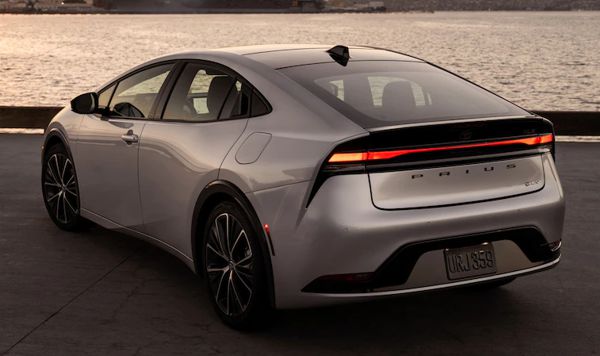 |
|
Not
exactly a hot or warm hatch, but it is quick, handsome and finally
feels normal to drive, while keeping superior fuel economy intact.
|
|
However, the Prius is not as sporty as its looks suggested. The
suspension tuning is still oriented to comfort, as is the light and
numb steering. The 195 mm tires offer no more than adequate grip. It is
more pleasant to drive than the past, unquestionably, but not to be
confused with a hot hatch. Meanwhile, it is not the most refined family
car either. Running on highway, road and engine noises are a bit more
than desired, as if Toyota doesn't want to add too much weight.
Ultimately, its biggest advantage over other family cars remains to be
fuel economy: 57 mpg for EPA combined cycles on 17-inch wheels or 52
mpg on 19-inch items. That compares favourably with the old car, which
was rated 52 mpg. As aforementioned, fuel economy alone doesn’t sell,
but the difference is this time around the Prius looks great outside,
goes quickly if you want and corners like a normal car, all the while
without denting its superior fuel economy. That’s its biggest
achievement.
|
Verdict:     |
|